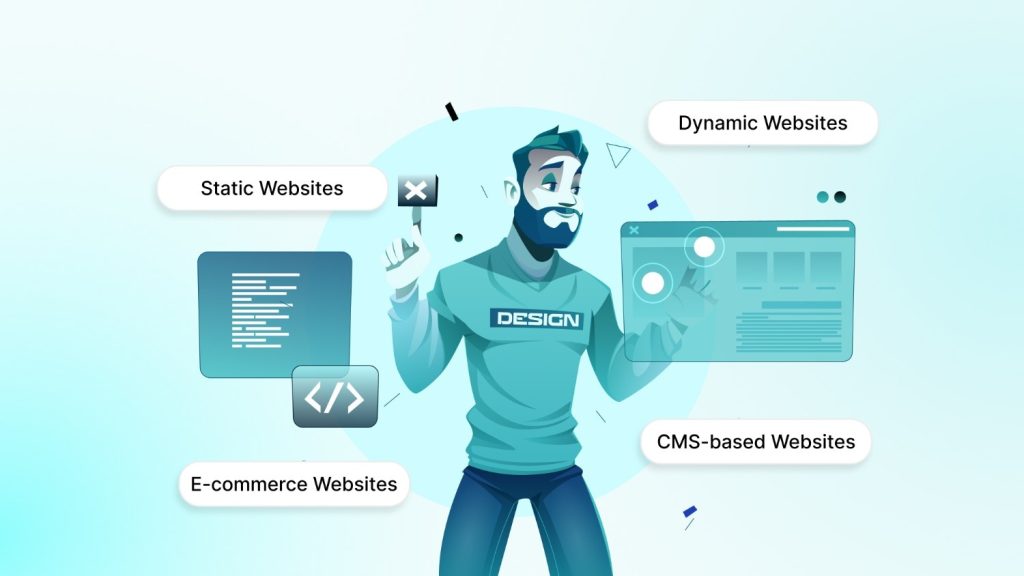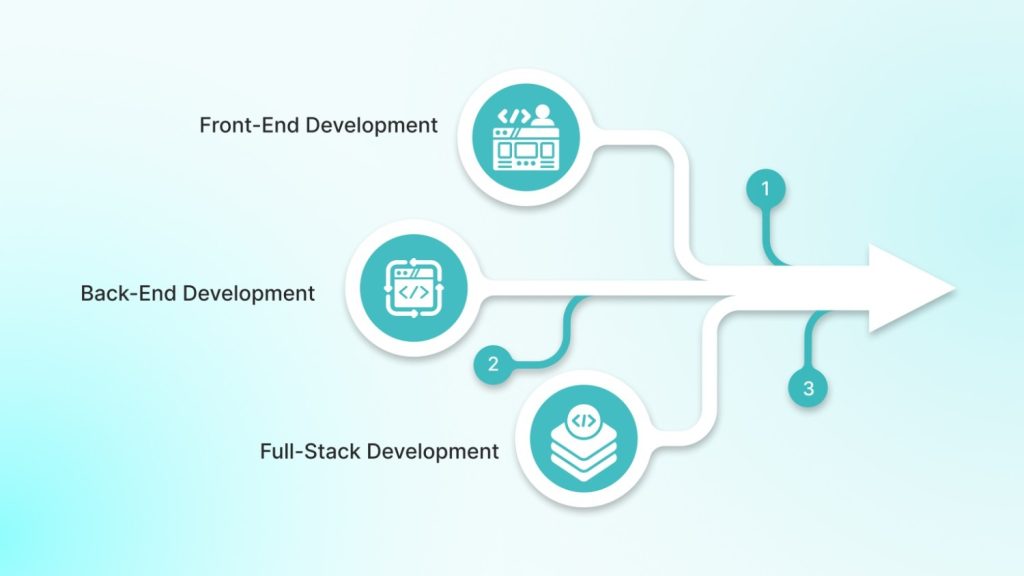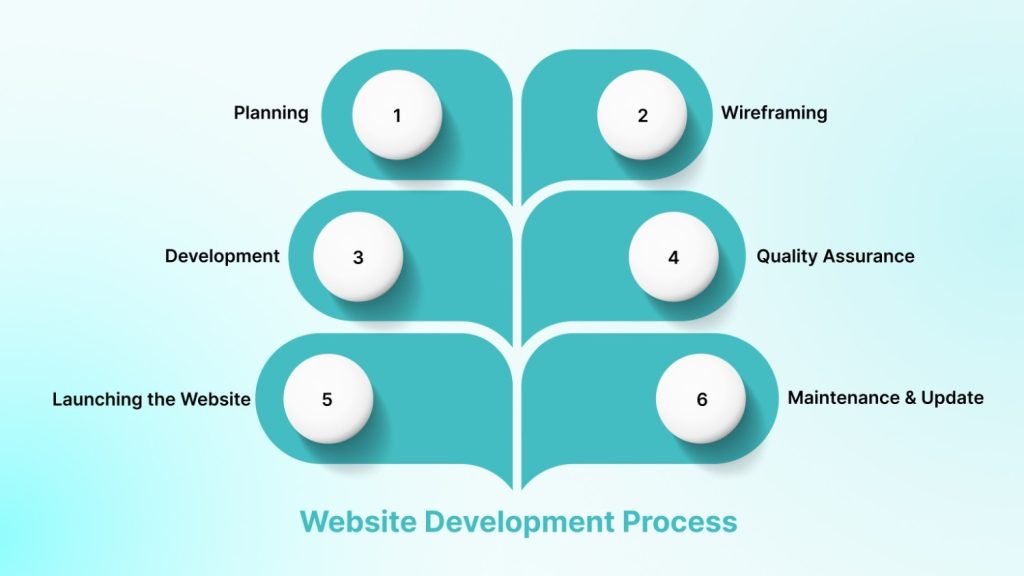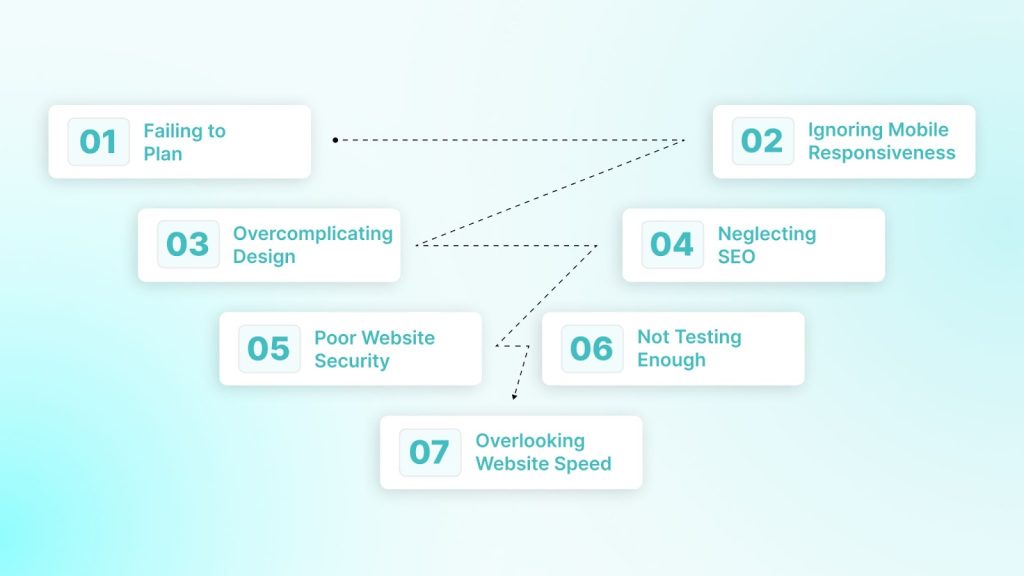In 2025, over 1.2 billion websites exist globally. Yet, a staggering 94% of users will leave a website simply because of poor design. This highlights a critical reality: your website’s design and functionality can make or break your online presence.
A well-designed, user-friendly website is not just an option; it is essential for building trust, enhancing user experience, and driving business success.
This guide will cover the fundamentals of website development, offering insights into the process, best practices, and tools you will need to get started.
Key Takeaways
- Website development is the process of creating and maintaining websites, involving tasks like coding, programming, and ensuring functionality.
- Front-end development focuses on the user interface and experience, while back-end development handles the server-side functionality and data management.
- Key mistakes to avoid in website development include neglecting mobile responsiveness, overcomplicating design, and failing to prioritize security.
- DEVtrust offers expert web development solutions, from front-end to full-stack development, ensuring scalable, secure, and high-performing websites for your business.
What is Website Development?
Website development refers to the process of building and maintaining websites. It involves creating everything from the structure to the functionality, ensuring the site is both visually appealing and fully operational. While web design primarily concentrates on visual elements, web development is concerned with transforming those designs into a functional website.
A web developer uses coding languages to create the backbone of a website. This includes writing the necessary code for functionality, such as interactive elements, forms, and navigation menus, while also ensuring the website runs smoothly and efficiently.
Key Tasks in Web Development
The process involves various tasks, including:
- Coding: Writing the actual code that powers the website.
- Programming: Creating logic and functionality for how the website behaves.
- Web Publishing: Making the website accessible online.
- Database Management: Organizing and managing data on the server.
- Maintaining the Website: Ensuring the site remains functional and up to date.
Types of Websites

Websites are classified into various types depending on their functionality.
- Static Websites: These are simple websites with fixed content. They do not require server-side processing and are ideal for personal blogs or informational pages.
- Dynamic Websites: These websites change content based on user interaction or other variables. They require server-side processing and can include e-commerce sites, social media platforms, and news websites.
- CMS-based Websites: Content Management Systems like WordPress or Joomla make it easy to manage and update content without needing to write much code.
- E-commerce Websites: These websites are specifically designed for online shopping. They handle product listings, payments, and customer interactions.
Difference Between Web Development, Web Design, and Web Programming
Web development, web design, and web programming represent distinct areas of website creation. Web development covers the overall process, including both design and functionality. Web design emphasizes the visual aspects and the overall user experience.. Web programming involves coding the functional aspects of a site, such as interactivity and server-side operations.
This table breaks down the key differences between the three.
| Aspect | Web Development | Web Design | Web Programming |
| Scope | A broad process that includes the creation, functionality, and maintenance of a website. | Concentrates on the design elements and overall user interaction (UI/UX) of a website. | Focuses specifically on writing the code and functionality of a website. |
| Responsibilities | Includes both front-end and back-end tasks, ensuring the site works and is maintained. | Creating the look, feel, and layout of the website. Ensuring the user interface is intuitive. | Writing code for website features, back-end systems, and managing data. |
| Key Tasks | Site architecture, coding, debugging, database management, and server-side functions. | Layout design, color schemes, typography, wireframing, and graphic design. | Writing scripts, building APIs, working with databases, and server-side scripting. |
| Tools & Technologies | HTML, CSS, JavaScript, PHP, Python, CMS, frameworks (React, Angular, etc.). | Figma, Adobe XD, Sketch, Photoshop, Illustrator. | PHP, Python, Ruby, JavaScript (server-side), SQL, Node.js. |
| End Result | A complete and operational website or web application that works across devices. | A visually appealing, user-friendly interface that engages visitors. | Working code that enables interactive features and processes data. |
| Role in Website | Ensures the site operates efficiently, both on the front-end and back-end. | Makes the website visually appealing and usable. | Powers the website’s functionality, ensuring it can handle tasks like form submissions and database interactions. |
| Maintenance | Regular updates for features, security, and overall site performance. | Periodic redesigns or updates for user experience and branding. | Debugging, troubleshooting, and updating code to ensure smooth functionality. |
The Key Types of Website Development

Website development is divided into three key areas: front-end development, back-end development, and full-stack development. Each has a distinct function in building a complete, functional website.
1. Front-End Development
Front-end development focuses on what users see and interact with on a website. This includes the website’s layout, design, navigation menus, buttons, and content display. Essentially, front-end developers are responsible for making the site visually appealing and user-friendly.
The main technologies used in front-end development include:
- HTML: Defines the structure and layout of web pages.
- CSS: Styles the web page, adjusting colors, fonts, and layout designs.
- JavaScript: Adds interactivity and dynamic features like animations, form validation, and pop-up windows.
- Frameworks: Tools like React, Angular, and Vue.js make it simpler to create interactive and adaptable user interfaces.
Ready to create user-friendly, engaging front-end experiences for your website? Let us build intuitive designs that capture your audience’s attention.
Contact DEVtrust for custom front-end solutions.
2. Back-End Development
Back-end development is the server-side of a website, the part users do not see, but that makes everything work behind the scenes. It involves working with databases, servers, and APIs to ensure data is correctly stored, processed, and transferred.
Key technologies for back-end development include:
- Server-Side Languages: Ruby, PHP, Python, and Node.js are common languages used to write the back-end logic.
- Databases: MySQL, MongoDB, and PostgreSQL store and manage data that websites need to function.
- APIs: Back-end developers work with Application Programming Interfaces (APIs) to facilitate interaction between the front-end and back-end..
3. Full-Stack Development
Full-stack developers are proficient in both front-end and back-end development. They handle the entire website, from the user interface to server management, ensuring everything works together smoothly. Full-stack developers are frequently sought after due to their ability to manage every aspect of web development.
Want the best of both worlds? At DEVtrust, our full-stack developers are ready to build a cohesive, efficient web solution that bridges front-end and back-end.
Talk to DEVtrust about your full-stack project today.
The Website Development Process

Website development is a detailed, step-by-step process. From planning to launch and beyond, each stage ensures the site meets both user needs and business goals. Here is a breakdown of the main stages in web development:
1. Planning and Information Gathering
The first step in website development is gathering information. This involves understanding the website’s purpose, goals, and target audience. During this phase, you will define what features the site should have, the type of content it will display, and how it will function. Having a clear vision and goals is crucial for successful website development.
Key tasks include:
- Defining website objectives.
- Analyzing the target audience.
- Deciding on the content and features required.
2. Design and Wireframing
Design is where the look and feel of the website are created. In this phase, wireframes and mockups are developed to show how the website will look and function. The wireframe is essentially a blueprint that outlines the layout and structure of the website.
Key tools used:
- Figma, Adobe XD for mockups and wireframes.
- UX design to guarantee smooth and intuitive navigation.
3. Development: Turning Design into Code
Once the design is finalized, it is time to start building the website. Front-end and back-end development come into play here, where the designs are turned into actual code. Developers use HTML, CSS, and JavaScript for the front-end, and server-side languages like PHP, Ruby, or Python for the back-end.
This phase involves:
- Implementing interactive elements and user interfaces.
- Setting up server-side functionalities (databases, APIs).
- Ensuring mobile responsiveness and cross-browser compatibility.
4. Testing and Quality Assurance
Testing ensures the website works properly across all devices and platforms. This includes checking for bugs, broken links, and ensuring that all interactive elements function as expected. It is also essential to test the website’s speed, performance, and security.
Tasks include:
- Functional testing (forms, buttons, links).
- Performance testing (page load speed, mobile responsiveness).
- Security testing (HTTPS, data encryption).
5. Launching the Website
Once testing is complete, it is time to launch the website. This step involves deploying the site to a live server and making it accessible to the public. It is important to make sure everything works as expected during the launch.
Key steps during launch:
- Final checks for functionality.
- Setting up hosting and a domain.
- Deploying files to a live server.
6. Maintenance and Updates
After launch, the website needs regular updates and maintenance. This includes adding new content, optimizing performance, and fixing any issues that arise. Regular updates to the website help it stay relevant to user needs and maintain security.
Tasks include:
- Regular software updates.
- Security audits.
- Performance monitoring and optimization.
Also Read: Custom Web Application Development Guide and Benefits
Common Website Development Mistakes to Avoid

Even seasoned developers can make errors in website development. By steering clear of these common mistakes, you can ensure your website functions properly, is user-friendly, and stays secure.
1. Failing to Plan
Skipping the planning phase is a big mistake. Without a clear vision of the website’s goals, target audience, and features, the development process can become disorganized. Not planning properly can cause delays, extra changes, and confusion.
2. Ignoring Mobile Responsiveness
With more users accessing websites on mobile devices, it is crucial to ensure your website is mobile-friendly. Neglecting mobile responsiveness can result in a bad user experience, driving visitors away from your site. Always test your website’s design and functionality on multiple screen sizes.
3. Overcomplicating Design
Complex layouts and excessive use of images, animations, or fonts can slow down the website and overwhelm users. Keep the design clean, simple, and intuitive. Prioritize functionality and simple navigation to enhance the user experience.
4. Neglecting SEO Best Practices
A website is only effective if people can find it. Neglecting search engine optimization (SEO) during the development process can lead to poor search engine rankings. Make sure your website adheres to SEO best practices, such as using proper meta tags, alt text for images, and optimizing for mobile.
5. Poor Website Security
Website security is often overlooked during development. Failing to implement basic security features, such as HTTPS, data encryption, and secure login systems, can leave your website vulnerable to attacks. Always prioritize security and regularly update software and plugins.
6. Not Testing Enough
Skipping testing or conducting only minimal testing can lead to missed bugs or functionality issues. Ensure that your website undergoes thorough testing across different browsers, devices, and networks. Check for broken links, errors, and other issues before launching.
7. Overlooking Website Speed
Website loading speed is a key element in user retention and SEO rankings. A slow website can frustrate users, leading them to leave before the site fully loads. Optimize images, reduce unnecessary scripts, and leverage caching techniques to improve site speed.
Website Development Tools for Beginners
Choosing the right tools can simplify the website development process, especially for beginners. These tools help with design, coding, debugging, and testing, making it easier to build a functional, user-friendly website.
1. Design Tools
Design tools are essential for creating wireframes, mockups, and prototypes before development begins. These tools help you visualize the layout and user interface of your website.
- Figma: A cloud-based design tool used to create interactive prototypes and wireframes.
- Adobe XD: Useful for designing high-fidelity prototypes and user flows.
- Sketch: A vector-based design tool mainly used for UI/UX design.
2. Development Tools
For developers, there are various tools that simplify coding and managing website files.
- Visual Studio Code: A popular code editor with extensions that support HTML, CSS, JavaScript, and more.
- Sublime Text: A fast and customizable text editor with syntax highlighting for different programming languages.
- GitHub: A version control platform to manage and track changes in code, making collaboration easier for teams.
3. Content Management Systems (CMS)
A CMS makes it easier for beginners to manage website content without needing to code extensively.
- WordPress: The most popular CMS, offering themes, plugins, and a user-friendly interface.
- Wix: A drag-and-drop website builder, ideal for beginners with no coding experience.
- Squarespace: A website builder that focuses on clean, elegant design with easy-to-use tools.
4. Testing and Debugging Tools
Testing and debugging are essential to make sure that your website functions correctly.
- Google Chrome DevTools: A built-in tool in Google Chrome for debugging and testing website performance.
- Pingdom: A tool for checking your website’s speed and performance.
- BrowserStack: Helps test your website’s responsiveness and functionality across different browsers and devices.
5. Version Control
Version control systems help you manage your codebase and collaborate with other developers.
- Git: A widely used version control system to track changes and maintain code history.
- GitHub: A platform that integrates with Git for hosting code, collaboration, and version tracking.
Security and Best Practices in Web Development

Websites are frequent targets for cyberattacks, and a single vulnerability can lead to data breaches, downtime, or loss of user trust.
Cyber threats like phishing, cross-site scripting (XSS), SQL injection, and brute-force attacks can have devastating effects on a website. Without strong security measures, these vulnerabilities can be exploited, compromising both the website’s functionality and the users’ personal data.
To protect your website, implement the following security measures:
1. Use HTTPS
Secure your website with HTTPS (SSL/TLS encryption) to secure data exchanged between users and the server. This ensures that sensitive information like passwords and credit card details is encrypted and secure from interception.
2. Sanitize User Input
Always sanitize and validate user input to prevent SQL injections, XSS attacks, and other forms of malicious input. Ensure that only trusted data is processed.
3. Password Security
Use strong password policies and ensure passwords are hashed (never stored in plain text). Implement multi-factor authentication (MFA) for an added layer of protection.
4. Regular Updates
Keep all software, frameworks, and plugins updated. Developers should apply patches as soon as they are released to protect against known vulnerabilities.
5. Data Encryption
Encrypt sensitive data both during transfer and while stored. This ensures that even if data is intercepted, it stays unreadable without the proper decryption key.
6. Limit Access Control
Implement proper user access control to restrict who has permission to access and edit different sections of the website. Use the principle of least privilege to ensure users have only the necessary access rights.
7. Backup Regularly
Regular backups ensure that in the event of a data loss or security breach, the website can be restored quickly with minimal damage.
8. Security Audits
Regularly audit your website’s security, test for vulnerabilities, and conduct penetration testing to identify weaknesses that attackers could exploit.
By integrating these security practices into the website development process, you can minimize risks and provide a safer, more reliable experience for your users.
Are you following industry best practices in your development process? Let us ensure your website is scalable, secure, and high-performing from day one. Book a free consultation with DEVtrust experts.
Conclusion
Website development is a complex process involving planning, design, coding, and ongoing maintenance. Understanding front-end, back-end, and full-stack development is key to building a functional, user-friendly, and secure website.
By following best practices and prioritizing security, you make sure your site fulfills both user needs and business goals. Ongoing updates and feedback are crucial for long-term success. Start small, learn the tools, and continue building your skills for a successful web development journey.
Ready to build a future-proof web solution that grows with your business? Let DEVtrust’s team bring your vision to life with tailored, secure, and scalable web development.
Website Development Basics: A Beginner's Guide
Learn website development basics with our beginner's guide! Explore front-end, back-end, and essential tools to start building your website today.
Contact Us


